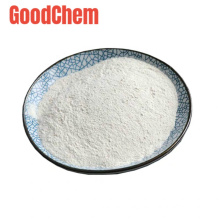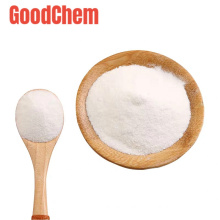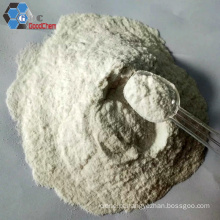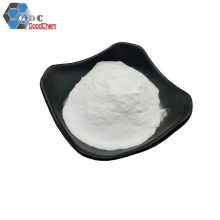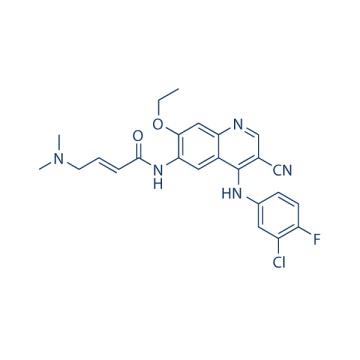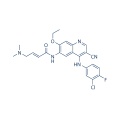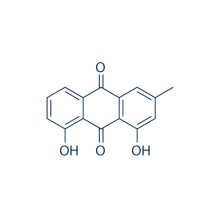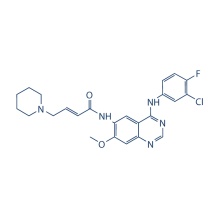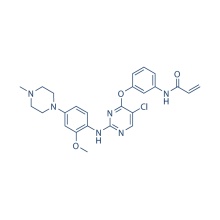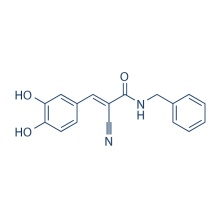.cp_wz table {border-top: 1px solid #ccc; border-left: 1px solid #ccc; } .cp_wz table td {border-right: 1px solid #ccc; borda inferior: 1px sólido #ccc; preenchimento: 5px 0px 0px 5px;} .cp_wz tabela th {border-right: 1px solid #ccc; border-bottom: 1px solid #ccc; preenchimento: 5px 0px 0px 5px;} \ n Peso molecular: \ n 467,92 Pelitinibe (EKB-569) é um potente inibidor irreversível de EGFR com IC50 de 38,5 nM. Fase 2. \ n Atividade biológica Pelitinibe exibe atividade inibitória muito maior contra EGFR, em comparação com o c-erbB-2 intimamente relacionado, bem como outras quinases como Src, Cdk4, c-Met, Raf e MEK / ERK, com IC50 variando de 282 nM para Src a> 20 μM para Cdk4. De forma consistente, o tratamento com Pelitinibe inibe significativamente a autofosforilação de EGFR, mas não c-Met em células A431. Pelitinib inibe potentemente a proliferação de queratinócitos humanos normais (NHEK), bem como células tumorais A431 e MDA-468 com IC50 de 61 nM, 125 nM e 260 nM, respectivamente, enquanto exibe pouca atividade contra células MCF-7 com IC50 de 3,6 μM. Pelitinib inibe a fosforilação de EGFR induzida por EGF em células A431 e NHEK com IC50 de 20-80 nM, bem como a fosforilação de STAT3 com IC50 de 30-70 nM. Pelitinibe a 75-500 nM também inibe especificamente a ativação de AKT e ERK1 / 2, sem afetar a via de NF-κB. Em células NHEK, Pelitinib também inibe potentemente a ativação de EGFR mediada por TGF-α com IC50 de 56 nM, bem como a ativação de STAT3 e ERK1 / 2 com IC50 de 60 nM e 62 nM, respectivamente. Uma dose oral única de 10 mg / kg de Pelitinibe inibe potentemente a fosforilação de EGFR em xenoenxertos A431 com EGFR superexpresso, em 90% em 1 hora e em> 50% após 24 horas. A administração de Pelitinibe a 20 mg / kg / dia inibe a tumorigênese em camundongos APCMin / + em 87%, equivalente ao efeito usado com 2 vezes as doses de EKI-785 (40 mg / kg / dia), consistente com maior potência in vivo . O pelitinibe inibe seletivamente a sinalização do EGFR nas células epiteliais das vias aéreas in vivo. No modelo de camundongo de remodelação epitelial das vias aéreas que é induzida por infecção viral e apresenta uma mudança retardada, mas permanente para metaplasia de células caliciformes, o tratamento com Pelitinibe a 20 mg / kg / dia corrige todos os 3 aspectos da remodelação epitelial, bloqueando completamente o aumento de células ciliadas células e diminuição das células de Clara, e inibindo significativamente a metaplasia das células caliciformes. Ensaio de cinase de protocolo (apenas para referência): [1]
|
Autophosphorylation of EGFR in cells
|
For experiments using cells in culture, A431 cells are treated with various concentrations of Pelitinib for 2.75 hours before co-incubation with 100 ng/mL EGF for 0.25 hour. Cells are washed twice with cold phosphate-buffered saline (PBS) before adding to lysis buffer (10 mM Tris, pH 7.5, 5 mM ethylenediamine tetra-acetic acid (EDTA), 150 mM NaCl, 1% Triton X-100, 1% Sodium deoxycolate, 0.1 % SDS, 1 mM PMSF, 10 mg/mL pepstatin A, 10 mg/mL leupeptin, 20 KIU/mL aprotinin, 2 mM sodium orthovanadate, and 100 mM sodium fluoride) for 20 minutes on ice, before immunoprecipitation and SDS-PAGE-immunoblotting. For immunoprecipitation, cultured cells are placed in cold lysis buffer and immediately homogenized on ice with a polytron with several pulses. The homogenate is first centrifuged at 2500 rpm (20 minutes, 4 °C) and then again at 14,000 rpm in a microcentrifuge (10 minutes, 4 °C). Supernatants (1000 μg protein) are incubated for 2 hours at 4 °C with 15 mL of EGFR polyclonal antibody. After 2 hours, 50 μL of protein G plus/protein A agarose beads is added and incubated with constant rotation for 2 hours at 4 °C. After washing with lysis buffer, beads are boiled for 2 minutes in Laemmli sample buffer. Proteins are then resolved by SDS-PAGE, transferred to immobilon membrane and probed overnight with an anti-phosphotyrosine antibody conjugated with horseradish peroxidase (HRP). Membranes are developed using the ECL reagent. Total EGFR protein is determined by stripping membranes and re-probing with receptor-specific antibodies. Quantitation of bands is done by densitometry, using ImageQuant software with a Molecular Dynamics laser transmittance scanner.
|
Ensaio de células: [2]
|
Cell lines
|
NHEK, A431, MCF-7, and MDA-468
|
|
Concentrations
|
Dissolved in DMSO, final concentrations ~10 μM
|
|
Incubation Time
|
5 days
|
|
Method
|
Cells are seeded in 96-well dishes, and after 2 hours, Pelitinib is added and incubated for 5 days. After incubation, the medium is removed from each well and fresh medium (150 μL) + 1 mg/mL MTT solution (50 μL) is added. After incubation for 2 hours at 37 °C, the medium is replaced with 150 μL DMSO, and absorbance at 540 nm in each well is determined. The IC50 is calculated by linear regression of the data.
|
Estudo Animal: [1]
|
Animal Models
|
Athymic nu/nu female mice bearing subcutaneous A431 tumors, or APCMin/+ male mice, a murine model of human familial adenomatous polyposis (FAP)
|
|
Formulation
|
Dissolved in pH 2.0 water
|
|
Dosages
|
10, or 20 mg/kg/day
|
|
Administration
|
Oral gavage
|
|
Solubility
|
30% PEG400/0.5% Tween80/5% propylene glycol,
30 mg/mL
|
|
* Please note that Selleck tests the solubility of all compounds in-house, and the actual solubility may differ slightly from published values. This is normal and is due to slight batch-to-batch variations.
|
Conversão de diferentes modelos de animais com base em BSA (valor com base em dados das diretrizes preliminares da FDA)
|
Species
|
Baboon
|
Dog
|
Monkey
|
Rabbit
|
Guinea pig
|
Rat
|
Hamster
|
Mouse
|
|
Weight (kg)
|
12
|
10
|
3
|
1.8
|
0.4
|
0.15
|
0.08
|
0.02
|
|
Body Surface Area (m2)
|
0.6
|
0.5
|
0.24
|
0.15
|
0.05
|
0.025
|
0.02
|
0.007
|
|
Km factor
|
20
|
20
|
12
|
12
|
8
|
6
|
5
|
3
|
|
Animal A (mg/kg) = Animal B (mg/kg) multiplied by
|
Animal B Km
|
|
Animal A Km
|
Por exemplo, para modificar a dose de resveratrol usada para um camundongo (22,4 mg / kg) para uma dose baseada na BSA para um rato, multiplique 22,4 mg / kg pelo fator Km para um camundongo e, em seguida, divida pelo fator Km para um rato. Este cálculo resulta em uma dose equivalente de rato para o resveratrol de 11,2 mg / kg.
|
Rat dose (mg/kg) = mouse dose (22.4 mg/kg) ×
|
mouse Km(3)
|
= 11.2 mg/kg
|
|
rat Km(6)
|
Informação Química
|
Molecular Weight (MW)
|
467.92
|
|
Formula
|
C24H23ClFN5O2
|
|
CAS No.
|
257933-82-7
|
|
Storage
|
3 years -20℃Powder
|
|
6 months-80℃in solvent (DMSO, water, etc.)
|
|
Synonyms
|
|
|
Solubility (25°C) *
|
In vitro
|
DMSO
|
13 mg/mL
(27.78 mM)
|
|
Water
|
<1 mg/mL
(
|
|
Ethanol
|
<1 mg/mL
(
|
|
In vivo
|
30% PEG400/0.5% Tween80/5% propylene glycol
|
30 mg/mL
|
* <1 mg/ml means slightly soluble or insoluble.
* Please note that Selleck tests the solubility of all compounds in-house, and the actual solubility may differ slightly from published values. This is normal and is due to slight batch-to-batch variations.
|
|
Chemical Name
|
(E)-N-(4-(3-chloro-4-fluorophenylamino)-3-cyano-7-ethoxyquinolin-6-yl)-4-(dimethylamino)but-2-enamide
|
Calculadora de molaridade Calculadora de diluição Calculadora de peso molecular
Grupo de Produto : Proteína Tirosina Quinase > Inibidor EGFR

